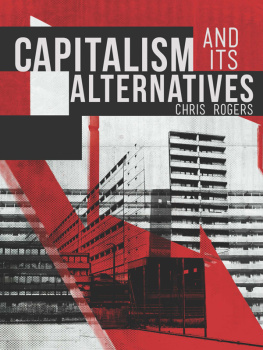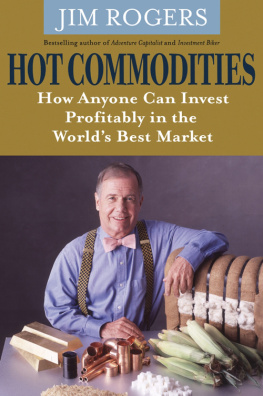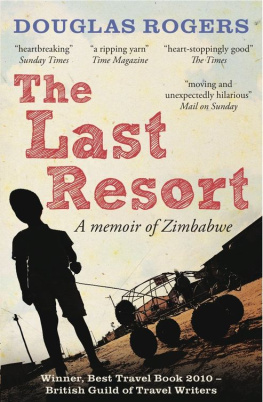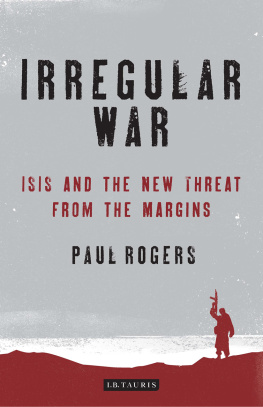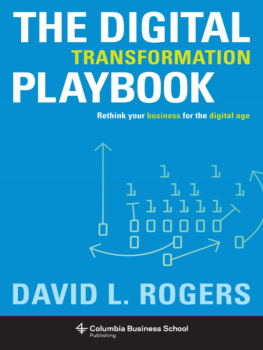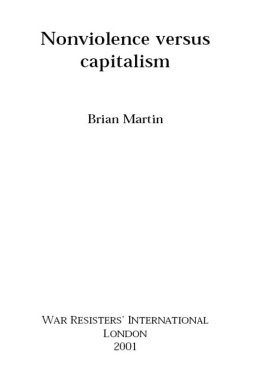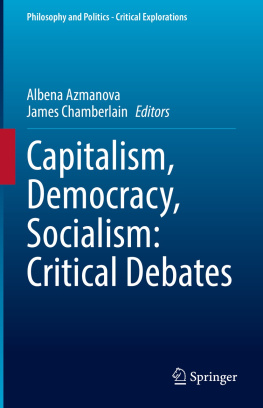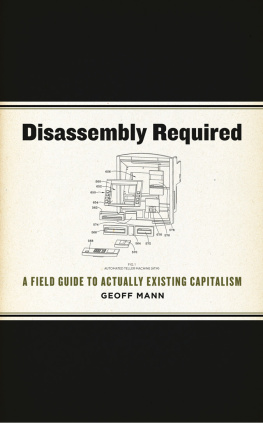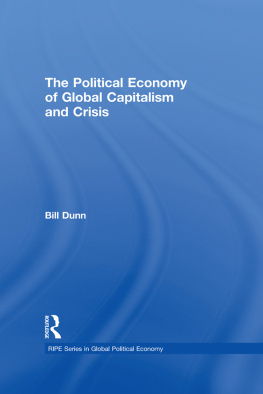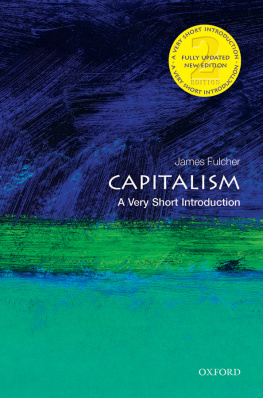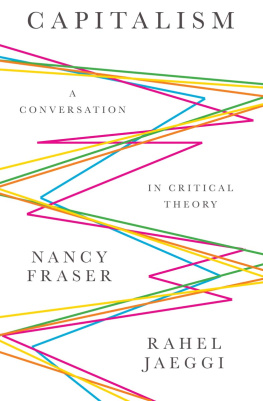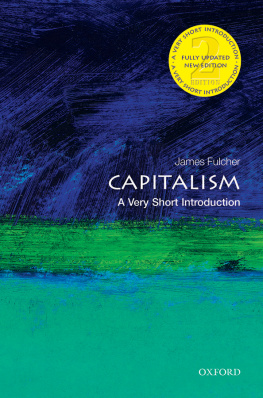
About the author
Chris Rogers is Leverhulme Early Career Fellow at the University of York. His first book, The IMF and European Economies: Crisis and Conditionality , was published in 2012. Chris is currently working on a research project on the political economy of mutual organization.
CAPITALISM AND ITS
ALTERNATIVES
Chris Rogers

Zed Books
LONDON
Capitalism and Its Alternatives was first published in 2014 by Zed Books Ltd, 7 Cynthia Street, London N1 9JF, UK
This ebook edition was first published in 2014
www.zedbooks.co.uk
Copyright Chris Rogers 2014
The right of Chris Rogers to be identified as the author of this work has been asserted by him in accordance with the Copyright, Designs and Patents Act, 1988
Set in Monotype Plantin and FFKievit by Ewan Smith, London
Index:
Cover designed by Steven Marsden
All rights reserved. No part of this publication may be reproduced, stored in a retrieval system or transmitted in any form or by any means, electronic, mechanical, photocopying or otherwise, without the prior permission of Zed Books Ltd.
A catalogue record for this book is available from the British Library
Library of Congress Cataloging in Publication Data available
ISBN 978-1-78032-739-6
CONTENTS
ACKNOWLEDGEMENTS
This book was written during a Leverhulme Early Career Fellowship (ECF-2011-003) and I am grateful to the Leverhulme Trust for the funding that allowed me to spend time thinking through the issues raised in the book. I would like to thank Ken Barlow at Zed Books for his help in developing the project in its early stages, as well as Werner Bonefeld, Charith Cabraal, Chris Clarke, Catia Gregoratti, Nicholas Larkman, Martin ONeill, Adrienne Roberts, Carole Spary, Kika Sroka-Miller, Ted Svensson, Matthew Watson and anonymous referees, all of whom have provided extremely useful comments and observations, either during ongoing discussions about the subject matter of the book, or on earlier drafts. All of these suggestions and discussions have contributed to improving the final text. The support and encouragement of friends and family while I was writing the book are, as ever, greatly appreciated. Finally, I would like to thank Ian Paten for his hard work in copy-editing the manuscript.
INTRODUCTION: CAPITALISM AND ITS ALTERNATIVES
Introduction
The collapse of sub-prime mortgage markets, which led to the failure of some financial institutions, the bailout of others, and the subsequent recession, has had profound implications. In Europe, both Greece and Spain have seen unemployment reach unprecedented heights of over 25 per cent. In May 2013, youth unemployment Europe-wide was 23.1 per cent; in Greece it was as high as 59.2 per cent and in Spain 56.5 per cent ().
The consequences of the global financial crisis have therefore been felt acutely at a social level throughout Europe and the world. In light of the fact that the crisis originated with the imprudent behaviour of financial actors, and the fact that costs associated with the crisis have been socialized in the form of unemployment and welfare retrenchment, it is perhaps unsurprising that there has been an upsurge of discontent about the way in which the capitalist system operates. This has been clearly manifested in the form of the Occupy movement, which has been one of the primary modes of resistance to the prevailing form of capitalism through its occupations of public spaces in New York, London and elsewhere. Discontent about how the benefits of the capitalist system are distributed has been clearly manifested in the slogan that it has popularized: we are the 99 per cent.
The global financial crisis of the late 2000s, the distribution of the benefits of the way the system operated, and the distribution of the costs of the way it was saved, provide strong reasons to think about whether capitalism is a desirable form of social and economic organization. However, this reasoning is amplified by the fact that it is not the first time that the capitalist system has found itself in crisis. In the 1930s, the Great Depression led to widespread unemployment that provoked international economic competition and contributed to the onset of the Second World War. This represented the ultimate socialization of the costs of capitalist failure; as John Holloway (: 21) phrased it, after the Great Depression and the Second World War capital could deal again and, over the bodies of twenty million people, a fresh game could start. In the 1970s, the global economy once again found itself in crisis as many countries were faced with rises in unemployment occurring along with stagnant growth the phenomenon of stagflation. While the crisis did not lead to war as it did in the interwar period, the 1970s stagflation nonetheless resulted in widespread cuts in welfare that meant people were exposed even further to the rigours of the marketplace. As such, if the market could not provide them with employment, people had increasingly less to fall back on for their well-being.
Although periods of vast economic growth, such as the years immediately following the Second World War and the 1990s and early 2000s, have suggested that such episodes have finally been overcome, and the cycles of boom and bust banished, these hopes have always turned out in the end to be illusory (tendency towards crisis that ultimately means an alternative system of organization is required if stability is to be achieved. Thirdly, the book asks what kind of alternative systems of organization might be realized, and what their consequences could be. Finally, the book asks how individuals and groups of individuals could create such an alternative form of social organization.
A note on terminology The book will draw on four core concepts. The first of these is capitalism . The term capitalism is used throughout the book to refer to the prevailing form of social organization. While acknowledging that the ways in which capitalism operates and the implications of these operations are contested, this book defines capitalism in terms of one commonly accepted distinguishing feature: that capitalism is a system that organizes the production, distribution and exchange of goods, on the basis of private property, with a view to realizing profit and therefore increasing wealth. The second term is alternative capitalism , which is used to describe a system where the capitalistic relationship between state and market is re-regulated, but not fundamentally reformed, in order to try to produce optimal social and economic outcomes. The aim of an alternative capitalism is to maximize wealth and profit by introducing a different structure of rules to govern capitalism. The third concept is that of an alternative to capitalism. An alternative to capitalism is distinct from capitalism because it places an emphasis on social and civic goals, rather than purely focusing on pecuniary gain. In contrast to capitalism, an alternative to capitalism is founded on collective or community property rights, rather than individual property rights, although the form and extent of collective or community property rights may vary. Where the book is referring to either an alternative capitalism or an alternative to capitalism, it uses the form alternative (to) capitalism. The final concept the book uses is anti-capitalism . It uses the term anti-capitalism to refer to the act of resisting capitalism, whether this occurs by attempting to influence the state, taking control of the state, or actions taken independently or outside of the state. An individual who pursues or wishes to pursue an alternative to capitalism can therefore be described as an anti-capitalist.
Next page
